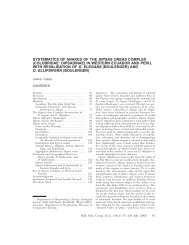cryptic species within the dendrophidion vinitor complex in middle ...
cryptic species within the dendrophidion vinitor complex in middle ...
cryptic species within the dendrophidion vinitor complex in middle ...
You also want an ePaper? Increase the reach of your titles
YUMPU automatically turns print PDFs into web optimized ePapers that Google loves.
SPECIES IN THE DENDROPHIDION VINITOR COMPLEX N Cadle 197<br />
Figure 6. Dendrophidion <strong>v<strong>in</strong>itor</strong> (KU 300784), <strong>the</strong> only known specimen from Belize. A color photograph of this specimen <strong>in</strong> life is<br />
<strong>in</strong> Lee (2000: fig. 315).<br />
Stafford and Meyer (2000: 200) and for <strong>the</strong><br />
color photograph <strong>in</strong> Lee (2000, fig. 315;<br />
Julian C. Lee, personal communication,<br />
January 2011); see Meerman and Lee (2003).<br />
Natural History. The few specimens of D.<br />
<strong>v<strong>in</strong>itor</strong> accompanied by habitat <strong>in</strong>formation<br />
suggest that it <strong>in</strong>habits relatively <strong>in</strong>tact<br />
forests, variously described as ‘‘ra<strong>in</strong>forest’’<br />
or ‘‘lower montane ra<strong>in</strong>forest’’ (e.g., Duellman,<br />
1960: 34, for Donají, Oaxaca; Johnson,<br />
1989: 64, for Chiapas). Goodw<strong>in</strong> (1969: 259)<br />
gave brief habitat notes on Oaxacan localities<br />
for specimens collected by Thomas MacDougall,<br />
as follows: La Gloria (coffee plantations,<br />
milpas, ra<strong>in</strong>forest; elevation about 1,500 ft.);<br />
Cerro Azul (‘‘cloud forest,’’ high north-fac<strong>in</strong>g<br />
slopes swept by gale-force w<strong>in</strong>ds, elevation of<br />
peaks to about 8,000 ft., collections from<br />
4,000 to 7,000 ft.); Cerro Atravesado (open<br />
p<strong>in</strong>e stands, grass and rocks, patches of<br />
‘‘cloud forest’’ at north end, some ranches<br />
on lower slopes. Elevation about 4,750 ft.).<br />
Few natural history or behavioral data<br />
seem to have been recorded for D. <strong>v<strong>in</strong>itor</strong>.<br />
Darl<strong>in</strong>g and Smith (1954: 191) found a<br />
juvenile coiled by a trail dur<strong>in</strong>g <strong>the</strong> day on<br />
Volcán San Martín, Veracruz, Mexico. Two<br />
specimens (FMNH 126554–55) are accompanied<br />
by notes <strong>in</strong>dicat<strong>in</strong>g <strong>the</strong>y were ‘‘<strong>in</strong><br />
heavy shade, <strong>in</strong> daytime, on ground.’’ Johnson<br />
et al. ‘‘1976’’ [1977] reported a male from<br />
near Ocozocuautla (Chiapas, Mexico) actively<br />
forag<strong>in</strong>g on <strong>the</strong> forest floor at 3:30 p.m. on<br />
28 December 1974. Alvarez del Toro (1972,<br />
1982) reported D. <strong>v<strong>in</strong>itor</strong> as ‘‘relatively<br />
common’’ <strong>in</strong> <strong>the</strong> hills surround<strong>in</strong>g Presa<br />
Malpaso, a large hydroelectric reservoir <strong>in</strong><br />
<strong>the</strong> Río Grijalva bas<strong>in</strong> of nor<strong>the</strong>rn Chiapas,<br />
Mexico; he stated that it <strong>in</strong>habits <strong>the</strong> shady<br />
parts of <strong>the</strong> forest and rapidly hides <strong>in</strong> <strong>the</strong><br />
leaf litter upon disturbance. At Los Tuxtlas<br />
Biological Station Perez-Higareda (1978)<br />
encountered D. <strong>v<strong>in</strong>itor</strong> much more frequently<br />
<strong>in</strong> <strong>the</strong> dry season and first half of <strong>the</strong> ra<strong>in</strong>y<br />
season (April–October), with a peak encounter<br />
rate <strong>in</strong> October, than <strong>in</strong> <strong>the</strong> period of<br />
more consistent heavier ra<strong>in</strong>s (November–<br />
March). Stomach contents of two specimens<br />
I exam<strong>in</strong>ed (576 and 248 mm SVL) each<br />
comprised a s<strong>in</strong>gle small frog (Pristimantis or<br />
Craugastor; 20 and 15 mm SVL, respectively).<br />
In contrast to some <strong>species</strong> of Dendrophidion,<br />
<strong>the</strong> frequency of broken/healed tails<br />
<strong>in</strong> D. <strong>v<strong>in</strong>itor</strong> is relatively low—13.7% of <strong>the</strong><br />
specimens exam<strong>in</strong>ed compared with 30% or<br />
more <strong>in</strong> some <strong>species</strong> (Stafford, 2003; Cadle,<br />
2010); this may <strong>in</strong>dicate a less easily pseudautotomic<br />
tail than o<strong>the</strong>r <strong>species</strong> or differential<br />
predation <strong>in</strong>tensities.<br />
Stafford (2003) <strong>in</strong>cluded specimens of D.<br />
<strong>v<strong>in</strong>itor</strong> as redef<strong>in</strong>ed here<strong>in</strong> <strong>in</strong> a study of<br />
morphology, diet, and reproduction of<br />
Bullet<strong>in</strong> of <strong>the</strong> Museum of Comparative Zoology harv-160-04-01.3d 11/4/12 19:58:50 197







